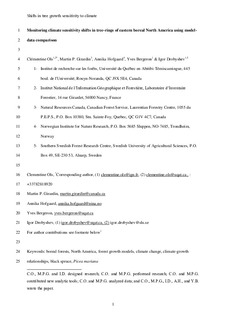| dc.contributor.author | Ols, Clementine | |
| dc.contributor.author | Girardin, Martin P. | |
| dc.contributor.author | Hofgaard, Annika | |
| dc.contributor.author | Bergeron, Yves | |
| dc.contributor.author | Drobyshev, Igor | |
| dc.coverage.spatial | Eastern boreal North America | nb_NO |
| dc.date.accessioned | 2017-12-07T10:05:49Z | |
| dc.date.available | 2017-12-07T10:05:49Z | |
| dc.date.created | 2017-11-28T11:16:06Z | |
| dc.date.issued | 2017 | |
| dc.identifier.issn | 1432-9840 | |
| dc.identifier.uri | http://hdl.handle.net/11250/2469531 | |
| dc.description.abstract | The growth of high-latitude temperature-limited boreal forest ecosystems is projected to become more constrained by soil water availability with continued warming. The purpose of this study was to document ongoing shifts in tree growth sensitivity to the evolving local climate in unmanaged black spruce (Picea mariana (Miller) B.S.P.) forests of eastern boreal North America (49_N–52_N, 58_W– 82_W) using a comparative study of field and modeled data. We investigated growth relationships to climate (gridded monthly data) from observed (50 site tree-ring width chronologies) and simulated growth data (stand-level forest growth model) over 1908–2013. No clear strengthening of moisture control over tree growth in recent decades was detected. Despite climate warming, photosynthesis (main driver of the forest growth model) and xylem production (main driver of radial growth) have remained temperature-limited. Analyses revealed, however, a weakening of the influence of growing season temperature on growth during the mid- to late twentieth century in the observed data, particularly in high-latitude (> 51.5_N) mountainous sites. This shift was absent from simulated data, which resulted in clear model-data desynchronization. Thorough investigations revealed that desynchronization was mostly linked to the quality of climate data, with precipitation data being of particular concern. The scarce network of weather stations over eastern boreal North America (> 51.5_N) affects the accuracy of estimated local climate variability and critically limits our ability to detect climate change effects on high-latitude ecosystems, especially at high altitudinal sites. Climate estimates from remote sensing could help address some of these issues in the future. boreal forests; North America; forest growth models; climate change; climate–growth relationships; black spruce; Picea mariana. | nb_NO |
| dc.language.iso | eng | nb_NO |
| dc.subject | boreal forests | nb_NO |
| dc.subject | North America | nb_NO |
| dc.subject | forest growth models | nb_NO |
| dc.subject | climate change | nb_NO |
| dc.subject | climate–growth relationships | nb_NO |
| dc.subject | black spruce | nb_NO |
| dc.subject | Picea mariana | nb_NO |
| dc.title | Monitoring climate sensitivity shifts in tree-rings of Eastern Boreal North America using model-data comparison. Shifts in tree growth sensivity to climate | nb_NO |
| dc.type | Journal article | nb_NO |
| dc.type | Peer reviewed | nb_NO |
| dc.description.version | acceptedVersion | nb_NO |
| dc.subject.nsi | VDP::Zoologiske og botaniske fag: 480 | nb_NO |
| dc.subject.nsi | VDP::Zoology and botany: 480 | nb_NO |
| dc.source.journal | Ecosystems (New York. Print) | nb_NO |
| dc.identifier.doi | 10.1007/s10021-017-0203-3 | |
| dc.identifier.cristin | 1519404 | |
| dc.relation.project | Norges forskningsråd: 160022 | nb_NO |
| dc.relation.project | Andre: NSERC Strategic and Discovery Grants | nb_NO |
| dc.relation.project | Andre: Nordic Forest Research Cooperation Committee (SNS) | nb_NO |
| dc.relation.project | Andre: Canadian Forest Service (CFS) | nb_NO |
| cristin.unitcode | 7511,2,0,0 | |
| cristin.unitname | Avdeling for terrestrisk økologi | |
| cristin.ispublished | true | |
| cristin.fulltext | postprint | |
| cristin.qualitycode | 2 | |
